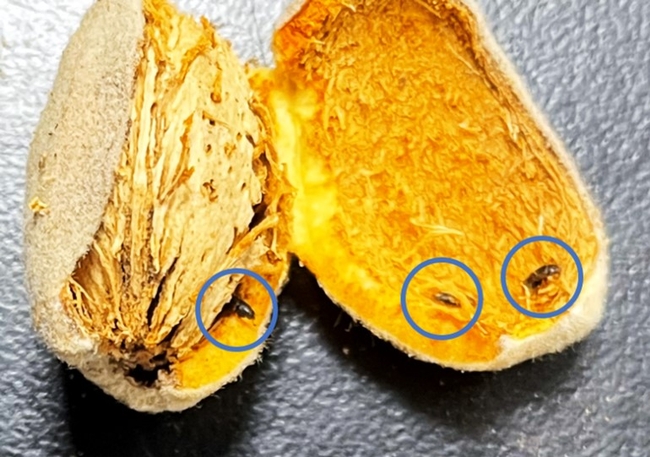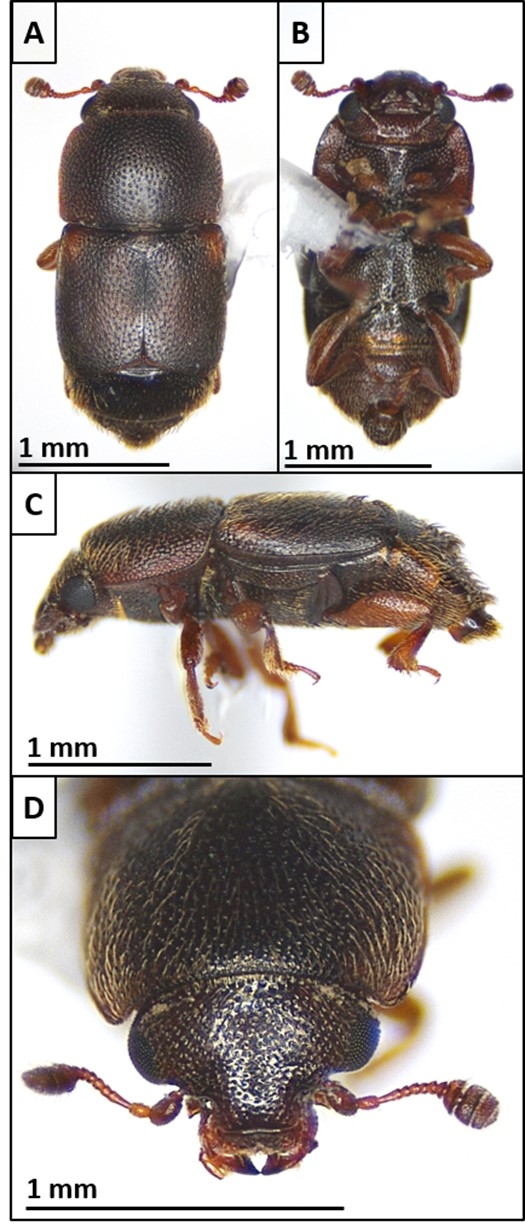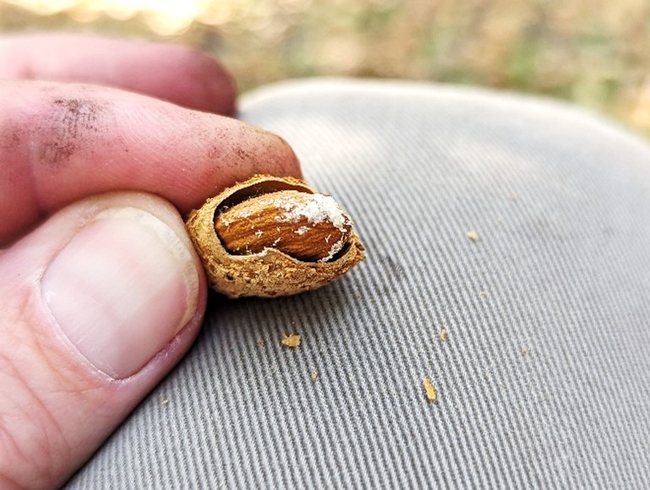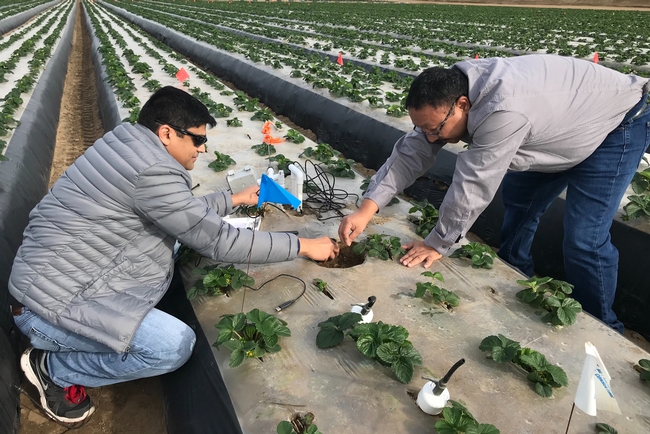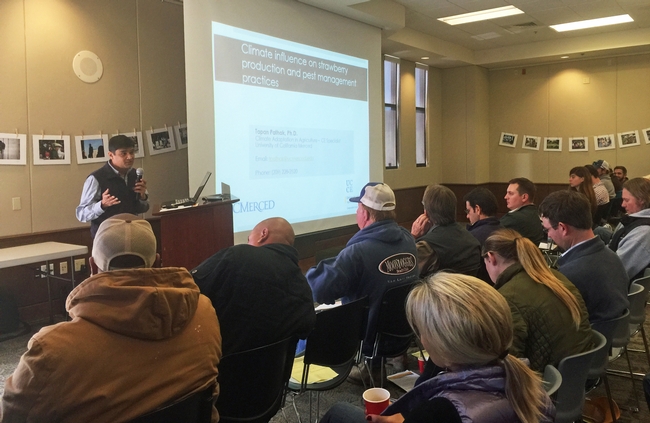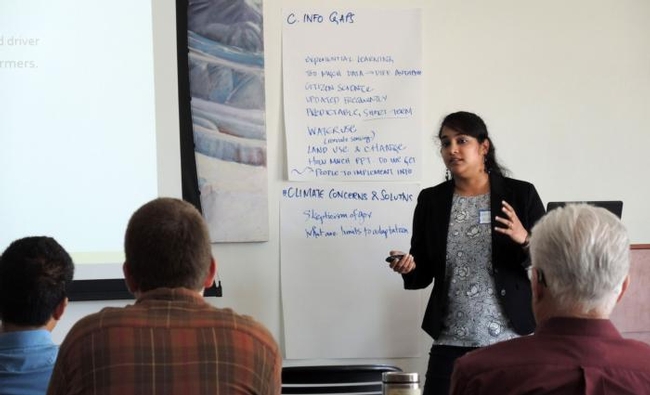Posts Tagged: Jhalendra Rijal
New pest infesting almonds and pistachios in the San Joaquin Valley
Crop sanitation will be key to controlling the invasive carpophilus beetle
Growers and pest control advisers (PCAs) should be on the lookout for a new pest called carpophilus beetle (Carpophilus truncatus). This pest was recently found infesting almonds and pistachios in the San Joaquin Valley, and is recognized as one of the top two pests of almond production in Australia. Damage occurs when adults and larvae feed directly on the kernel, causing reductions in both yield and quality.
Populations of carpophilus beetle were first detected in September in almond and pistachio orchards by University of California Cooperative Extension Specialist Houston Wilson of UC Riverside's Department of Entomology. Pest identification was subsequently confirmed by the California Department of Food and Agriculture.
Wilson is now working with Jhalendra Rijal, UC integrated pest management advisor, North San Joaquin Valley; David Haviland, UCCE farm advisor, Kern County; and other UCCE farm advisors to conduct a broader survey of orchards throughout the San Joaquin Valley to determine the extent of the outbreak.
To date, almond or pistachio orchards infested by carpophilus beetle have been confirmed in Stanislaus, Merced, Madera and Kings counties, suggesting that the establishment of this new pest is already widespread. In fact, some specimens from Merced County were from collections that were made in 2022, suggesting that the pest has been present in the San Joaquin Valley for at least a year already.
“It has likely been here for a few years based on the damage we've seen," Rijal said.
This invasive beetle overwinters in remnant nuts (i.e. mummy nuts) that are left in the tree or on the ground following the previous year's harvest. Adults move onto new crop nuts around hull-split, where they deposit their eggs directly onto the nut. The larvae that emerge feed on the developing kernels, leaving the almond kernel packed with a fine powdery mix of nutmeat and frass that is sometimes accompanied by an oval-shaped tunnel.
Carpophilus beetle has been well-established in Australia for over 10 years, where it is considered a key pest of almonds. More recently, the beetle was reported from walnuts in Argentina and Italy as well. Carpophilus truncatus is a close relative to other beetles in the genus Carpophilus, such as the driedfruit beetle (C. hemipterus) that is known primarily as a postharvest pest of figs and raisins in California.
Monitoring for carpophilus beetle is currently limited to direct inspection of hull split nuts for the presence of feeding holes and/or larvae or adult beetles. A new pheromone lure that is being developed in Australia may soon provide a better monitoring tool for growers, PCAs and researchers.
“We're lucky to have colleagues abroad that have already been hammering away at this pest for almost a decade,” said Haviland. “Hopefully we can learn from their experiences and quickly get this new beetle under control.”
The ability to use insecticides to control carpophilus beetle remains unclear. The majority of the beetle's life cycle is spent protected inside the nut, with relatively short windows of opportunity available to attack the adults while they are exposed. The location of the beetles within the nut throughout most of their life cycle also allows them to avoid meaningful levels of biological control.
In the absence of clear chemical or biological control strategies, the most important tool for managing this beetle is crop sanitation.
“Given that this pest overwinters on remnant nuts, similar to navel orangeworm, crop sanitation will be fundamental to controlling it,” Wilson said. “If you needed another reason to clean up and destroy mummy nuts – this is it.”
In Australia, sanitation is currently the primary method for managing this pest. And here in California, new research and extension activities focused on carpophilus beetle are currently in the works.
“It's important that we get on top of this immediately,” said Wilson. “We're already starting to put together a game plan for research and extension in 2024 and beyond.”
If you suspect that you have this beetle in your orchard, please contact your local UC Cooperative Extension farm advisor (https://ucanr.edu/About/Locations/), County Agricultural Commissioner (https://cacasa.org/county/) and/or the CDFA Pest Hotline (https://www.cdfa.ca.gov/plant/reportapest/) at 1-800-491-1899.
Climate-change research provides tools for farmers to adapt
This is one of a series of stories featuring a sampling of UC ANR academics whose work exemplifies the public value UC ANR brings to California.
Farmers are already seeing the effects of warmer winter nights and hotter summer days on their crops. Climate change is gradual, but increasing overall temperatures affect many aspects of farming, including where and how crops are grown. Tapan Pathak, University of California Cooperative Extension specialist based at UC Merced, is doing applied research that farmers and ranchers can use to adapt to new conditions created by a variable and changing climate.
“You don't have to shift your practice tomorrow, but if you are thinking of making a 30-year investment, it's important to know what risks there are for planting different crops,” said Pathak, who is based in the Sierra Nevada Research Institute at UC Merced.
Pathak co-chairs the UC Cooperative Extension Climate Change Program Team, whose mission is to increase the capacity among UCCE academics to address climate change concerns with science-based information. Pathak also collaborates with extension professionals from across the western U.S. to do extension events related to climate change adaptation. He works closely with state and federal agencies statewide and growers to identify changes occurring as a result of climate change that affect agriculture. Pathak's research will inform growers' decisions, such as crop variety, planting and harvest dates, extreme heat and frost protection and pest management.
“We are seeing impacts of climate change, that's evident. We have some solutions that are available, but we also need to do more locally relevant crop specific research to make agriculture resilient to climate risks,” Pathak said.
The UCCE scientist was the lead author on an important paper that synthesized the impacts of climate change on California agriculture and offers directions for future research and implementation. The authors concluded that almost all of California's crops, collectively valued at more than $50 billion a year, will be endangered to some degree by rising temperatures and variable weather patterns. The study “Climate Change Trends and Impacts on California Agriculture” was published in Agronomy in 2018.
“I think there's a lot of solutions available and there is also a clear need for adaptation research that include growers' perspectives,” said Pathak, who received a Climate Leadership Award for research from the California Climate & Agriculture Network.
Pathak is also collaborating very closely with UC Davis-based UCCE specialist Daniele Zaccaria, who is leading an international project on evaluating bioclimatic indices and developing the index that is more relevant to irrigated agriculture, which includes scientists from the U.S., Italy, Brazil and Chile.
“A bioclimatic index specific to irrigated agriculture can provide more accurate and valuable agricultural drought information that could be helpful for water resources planning and management decisions,” Pathak said.
Cal AgroClimate
Pathak is developing a web-based decision support system called Cal AgroClimate to help growers make decisions, in partnership with the USDA California Climate Hub director Steven Ostoja. It is being built on the same platform as AgroClimate, which is popular with growers in the Southeast.
Cal AgroClimate translates historical climate data and future projections into a useful decision support system for growers. For example, growers can get extreme heat and frost advisories for the next 10 to 14 days in their region and relevant resources to mitigate risks for their selected crop. It is in the early phase of development and will include a suite of tools based on the needs and priorities identified by UCCE colleagues, growers and the agricultural community in general.
In addition to his work on Cal AgroClimate, Pathak has been conducting research on specific crops.
Tomatoes
In a study looking at processing tomato production in the Central Valley, Pathak and UCCE advisor Scott Stoddard found that changing temperatures will likely change the tomato growing season. The scientists looked at processing tomato data starting from 1950 and projections for 2030-2040 to see how the time to maturity is changing.
“In general, the time from emergence to maturity, the timeframe for processing tomatoes in that region is going to shrink by two to three weeks,” said Pathak. “A lot of processors have their timeline for when they need the tomatoes for processing and so when you have this shift in the phenology, that alters the timeframe for when they mature and are ready for the processors. So, there's a whole shift in the management that growers might have to think about in the future.”
Almonds
To identify the climate information almond growers need to take adaptation action, UC Berkeley postdoctoral researcher Kripa Jagannathan, former UCCE advisor David Doll and Pathak interviewed almond growers in the Central Valley. During their conversations with farmers, the researchers clarified that long-term climate projections are not seasonal forecasts or weather forecasts for the next 20 to 30 years. The projections provide information on trends or potential of shifts from historical conditions for making long-term planning decisions.
Pest control is one area where growers will need to make changes. Research by UCCE advisor Jhalendra Rijal and Pathak shows the almond pest navel orangeworm is already extending its life to a fifth generation during a season.
Strawberries
For strawberries, Pathak, UCCE entomology and biologicals advisor Surendra Dara and postdoctoral researcher Mahesh Maskey have developed a model to forecast weekly crop yields based on weather data. “The model was pretty accurate for the Santa Maria region,” Pathak said. “A crop-specific model can be used for labor management not just crop management.”
Because California produces more than 400 agricultural products, adapting to climate change will be more complex than in other states.


